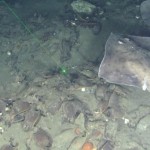Part two of four in a series about Greenpeace recent manned submersible expedition to two of the largest submarine canyons in the world, the Pribilof and Zhemchug Canyons in the Bering Sea off the west coast of Alaska.
 So, why would an environmental organization like Greenpeace go to the trouble of training staff to pilot a pair of manned submersibles through 2000 feet of water in the two largest submarine canyons in the world, the Pribilof and Zhemchug Canyons, in the heart of the Bering Sea?
So, why would an environmental organization like Greenpeace go to the trouble of training staff to pilot a pair of manned submersibles through 2000 feet of water in the two largest submarine canyons in the world, the Pribilof and Zhemchug Canyons, in the heart of the Bering Sea?
Because it’s going to be a long, long time before federal agencies are willing to surrender the necessary financing to secure a ship, ROVs, and submersibles. By the time you put together a research team to write a proposal and win the grant in the right funding cycle, the seafloor off Alaska could be bottom trawled with dragnets one hundred times over.
Native Alaskan fishermen don’t want to wait and watch while their natural resources disappear to bottom trawling, so some have turned to Greenpeace to help accumulate the evidence they need to put a management plan before the North Pacific Fisheries Management Council. Native Alaskans are hoping to win protection for the submarine canyons and their resources.
 Over the course of the two week expedition, the scientific party collected and identified several species of deep sea corals in new and unexpected settings, they documented trawl tracks, even landed in one, and they were attacked by a school of squid that sent one of the submarines topside. The picture below is an example of the habitat they encountered there, showing an octocoral, anemone, and hydroids around a small dropstone at 1071 feet. Thanks to OceanDoctor for the image.
Over the course of the two week expedition, the scientific party collected and identified several species of deep sea corals in new and unexpected settings, they documented trawl tracks, even landed in one, and they were attacked by a school of squid that sent one of the submarines topside. The picture below is an example of the habitat they encountered there, showing an octocoral, anemone, and hydroids around a small dropstone at 1071 feet. Thanks to OceanDoctor for the image.
The following interviews are exclusive to Deep Sea News. John Hocevar is an ocean specialist with Greenpeace. John was a coordinator of the cruise, and one of three Greenpeace submarine pilots. Dr. David Guggenheim is a ‘veteran’ submarine pilot from the Sustainable Seas expeditions. He joined the Bering Witness expedition as a sub pilot, partner, and scientific advisor. Dr. Guggenheim is the founder of 1planet1ocean and the “OceanDoctor” blog, pictured sitting in the Deep Worker submersible below.







I just read your artical and I found it very informative. I was just wondering during your expiditions in alsaska have you ever found anything unusual underwater around alaska? This question that I’m about to ask may sound unusual but I hope you can answer me seriously, have you ever found an underwater temple or have you ever had your sonar pick up something like a structure in the water around alaska? I’m not a crazy person, I just would like to know if you found it. Please answer me seriously. Thanks for your time and I hope to hear from you soon. Bye